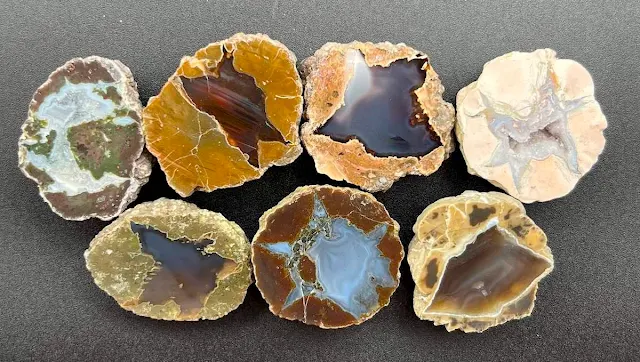Thunder egg: Ordinary Rocks With Crystal Surprise Inside!
A thunderegg is a spherical or ovoid nodule-like rock, similar to a filled geode, formed within rhyolitic volcanic ash layers as a concretion of silica (usually chalcedony), often containing a cavity lined with crystals, typically agate or quartz.
Thundereggs usually look like ordinary rocks on the outside, but slicing them in half and polishing them may reveal intricate patterns and colors. A characteristic feature of thundereggs is that (like other agates) the individual beds they come from can vary in appearance, though they can maintain a certain specific identity within them.
Thundereggs are rough spheres, most about the size of a baseball—though they can range from a little more than a centimeter to over a meter across. They usually contain centers of chalcedony which may have been fractured followed by deposition of agate, jasper or opal, either uniquely or in combination.
Thunderegg Vs. Geode
Thunderegg is not synonymous with either geode or agate. A geode is a simple term for a rock with a hollow in it, often with crystal formation/growth. A thunderegg on the other hand is a specific geological structure. A thunderegg may be referred to as a geode if it has a hollow in it, but not all geodes are thundereggs because there are many different ways for a hollow to form. Similarly, a thunderegg is just one of the forms that agate can assume.
Thunderegg Formation
Thundereggs are found in flows of rhyolite lava. They form in gas pockets in the lava, which act as molds, from the action of water percolating through the porous rock carrying silica in solution. The cooled bubbles were gradually filled by water percolating through the porous rock carrying rich quantities of silica (quartz).
The deposits lined and filled the cavity, first with a darker matrix material, then an inner core of agate or chalcedony. The various colors come from differences in the minerals found in the soil and rock that the water has moved through.
The agate, chalcedony, and quartz veins and open-space-fillings within voids in the spherulites formed later by multiple cycles of hydrothermal fluids. Hydrothermal fluids are a mixture of late-stage fluids escaping the magma and local ground water.
The fluids contain some elements from the original magma and also dissolved minerals from the country rock. The amount of ions that the fluid can dissolve depends upon pH, temperature, pressure, and composition of the fluid. The hydrothermal fluids move through fractures in the rocks, which crosscut the igneous textures, and form veins or banded agate, chalcedony, and quartz.
Some of these fluids seep through microscopic pores and into spherulites and gas pockets in the volcanic rocks, and they precipitate crystals along the walls of the cavity, forming geodes and geode-like spherulites. Other fluids seep through fractures and gas and other void spaces in the spherulites. Because of their formation by multiple hydrothermal events, each thunderegg provides clues as to its unique formation.
How to Spot Thundereggs
Though thundereggs appear as rocks, they can be easily identifiable by the abnormally round and bumpy brown-gray exteriors. Usually, thundereggs lie relatively close to the Earth's surface, embedded in the clay of the tuff, where they were formed. During the time, the tuff has been decayed to soft mud and clay, making rock-like thundereggs noticeable.
Where to Find Thundereggs
Thundereggs are found globally where conditions are optimal. In the US, Oregon is one of the most famous thunderegg locations. The regions of Central and Eastern Oregon are the most popular in the world for thundereggs hunting. The best productive areas are located in the high desert of Central Oregon near Prineville, Madras and in the Ochoco National Forest (Central Oregon). Also, thundereggs can be collected in Succor Creek Creek Canyon (Eastern Oregon)
United States:
Oregon: The undisputed thunderegg capital of the world! Central and Eastern Oregon, particularly the Ochoco National Forest near Prineville and Madras, offer abundant opportunities. Look for areas with exposed volcanic rock and clay deposits.
Idaho: The Owyhee Desert in southwestern Idaho is another hotspot for thundereggs, especially in the Succor Creek area.
California: The Mojave Desert in Southern California, particularly near Barstow and Apple Valley, holds promise for dedicated hunters.
Wyoming: The Thunder Egg Park near Lander offers a unique experience, with designated digging areas and educational resources.
 |
| Oregon Thunder Egg |
International Locations:
Germany: The St. Egidien and Gehlberg regions are known for their high-quality thundereggs, often featuring intricate patterns and vibrant colors.
Mexico: The Chihuahua Desert, particularly near Ciudad Jiménez, offers a chance to find unique thundereggs with a Mexican flair.
Australia: Mount Hay and Tamborine Mountain in Queensland are known for their colorful thundereggs, with some even containing opals.






%20(1).webp)



